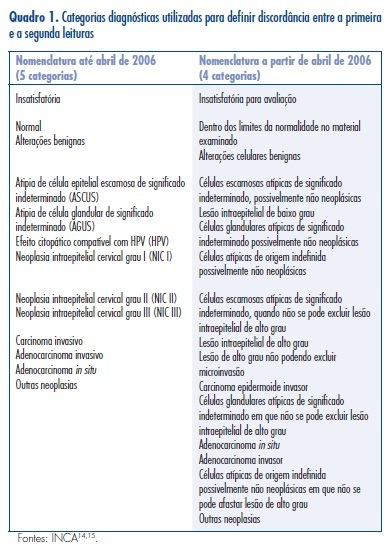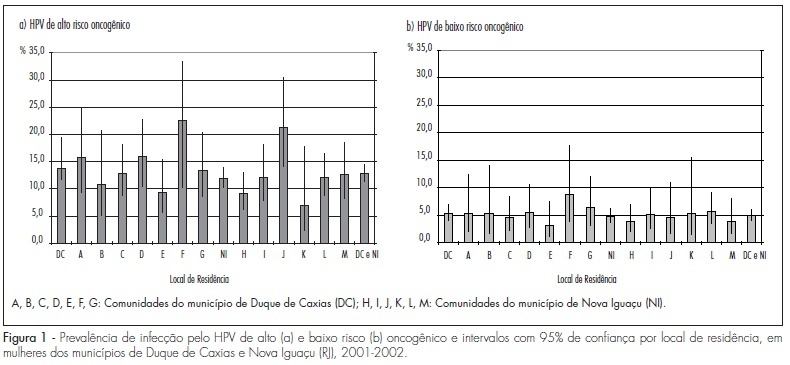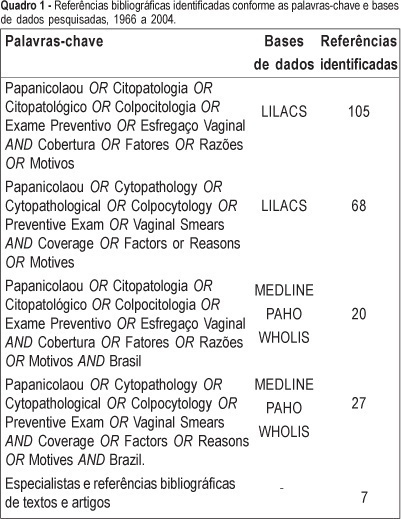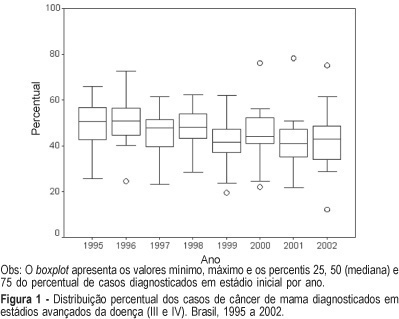You searched for:"Luiz Claudio Santos Thuler"
We found (17) results for your search.Summary
Rev Bras Ginecol Obstet. 2010;32(7):321-326
DOI 10.1590/S0100-72032010000700003
PURPOSE: to study the association between hypothyroidism and depression and anxiety symptoms. METHODS: a case-control study was carried out from July 2006 to March 2008 on 100 patients (50 patients with primary hypothyroidism and 50 euthyroid controls) aged 18 to 65 years. Age, race/skin color, marital status, education level, alcohol use, working status, body mass index and menopausal status were evaluated. TSH levels were determined and the Beck Depression and Beck Anxiety Scales were applied to all cases and controls. Statistical analysis was performed using the SPSS software version 14.0. The level of significance was set at p<0.05. RESULTS: there was no demographic or epidemiologic difference between groups. The concomitant presence of anxiety and depression was five times greater among cases than among controls (20.0 versus 4.0%, p=0.01). Anxiety symptoms were approximately three times more frequent among cases (40.0%) than among controls (14.0%) (p=0.003), while the prevalence of depressive symptoms was 75% higher among cases (28.0%) than among controls (16.0%), but this did not reach statistical significance (p=0.15). We found no association between TSH levels and the prevalence of anxiety or depression symptoms. CONCLUSIONS: this case-control study showed a greater probability for hypothyroid patients to develop anxiety and depression symptoms when compared to euthyroid controls. Due to the high prevalence of hypothyroidism and depression observed in clinical practice, depressive symptoms must be considered in patients with thyroid dysfunction and depressed patients should be tested for TSH.
Summary
Rev Bras Ginecol Obstet. 2012;34(8):351-356
DOI 10.1590/S0100-72032012000800002
PURPOSE: To evaluate the diagnostic agreement between the cytopathology reports issued by accredited laboratories and those obtained by quality control. METHODS: We calculated the overall agreement and Cohen's kappa coefficients of a convenience sample of smears selected monthly by the Information System of Cervical Cancer (SISCOLO) for External Quality Control of the 15 laboratories that performed cytopathological PAP tests for the Brazilian Public Health System (SUS) between 2002 and 2011 in Mato Grosso do Sul, a State of the Midwest Region of the country. A comparison of the reliability values (coefficient of concordance and Kappa coefficient) between the initial and final years was computed by the absolute change (delta) and relative percent difference (RPD). RESULTS: There were 15.989 smears sent for rereading, 48.1% of which had a report of normal/benign changes, followed by atypical/low-grade squamous intraepithelial lesions (36.3%), high grade squamous intraepithelial lesion/carcinoma/adenocarcinoma (4.2%), and unsatisfactory (11.4%). The overall correlation coefficient ranged between 0.2 and 1.0, and the median value increased from 0.7 in 2002 to 1 in 2011 (RPD=+36.6%). During the same period, the median values of the Kappa coefficient increased from 0.5 to 0.9 (RPD=+80.8%). CONCLUSIONS: These results emphasize the feasibility of the External Quality Control of cytopathology at the state level and its implementation results in improvement in the diagnoses performed in the SUS network.

Summary
Rev Bras Ginecol Obstet. 2010;32(1):39-46
DOI 10.1590/S0100-72032010000100007
PURPOSE: to evaluate the prevalence of HPV infection and associated factors among women living in the "Baixada Fluminense", state of Rio de Janeiro, Brazil. METHODS: a cross-sectional study conducted on a sample of 2,056 women aged 25-59 years covered by the Family Health Program in the municipalities of Duque de Caxias and Nova Iguaçu, state of Rio de Janeiro, southeastern Brazil. All women were submitted to the Papanicolaou and HPV detection tests in a single session by second-generation hybrid capture from December 2001 to July 2002. The prevalence of HPV was stratified by age, place of residence, schooling, smoking habit, and sexual and reproductive history. The prevalence rates associated with the studied variables were calculated by Multivariate Poisson regression. RESULTS: the prevalence of HPV was 12.3% and 5.0% for high-risk and low-risk HPV types, respectively. A reduction in high-risk HPV prevalence was observed with aging, with an increase in the 55-59 year age range. After adjusting for age, schooling, smoking, early sexual initiation and parity, high-risk HPV infection was associated with not living with a partner (1.4; 95%CI=1.1-1.8) and having more than one sexual partner (an increase of 1.4%; 95%CI=1.1-1.6, for each lifetime sexual partner). CONCLUSIONS: the prevalence of HPV was lower than that reported in other Brazilians studies, most likely because our sample was population-based. HPV infection was associated only with factors related to sexual behavior, but the potential association between HPV infection and smoking still needs to be better understood. Further studies are needed to explore these issues, as well as postmenopausal increased infection rates, and to identify the most prevalent HPV types in the Brazilian population.

Summary
Rev Bras Ginecol Obstet. 2015;37(9):397-401
DOI 10.1590/SO100-720320150005353
To evaluate the frequency and risk factors for the development of phantom breast syndrome in patients submitted to mastectomy after breast cancer treatment.
A cohort study of women undergoing treatment at the Hospital of Cancer III, National Cancer Institute José Alencar Gomes da Silva (INCA) from September 2008 to June 2009. PBS was considered based on report of phantom breast sensation and/or phantom breast pain. The study was approved by the Research Ethics Committee of the INCA (015/08). Descriptive analysis using absolute and relative frequency was performed. To evaluate the association between PBS and potential risk factors, univariate analysis was performed by means of odds ratios (OR) with respective 95% confidence intervals (95%CI).
A total of 88 patients were included. The frequency of PBS observed was 44.3 at 45 days (first follow-up) and 18.2% at 2 years (last follow-up). Most women reported phantom breast syndrome in all segments (37.1; 30.1 and 22%). During the six month follow-up, women under the age of 60 years had a 3.93 times higher risk of PBS (OR=3.9; 95%CI 1.4-10.5) and those with higher education (8 years or more of study) had a higher risk of developing PBS (OR=2.6; 95%CI 1.01-6.8).
The study population had a high frequency of PBS, which decreased over postoperative follow-up. Its occurrence after six months was higher among younger and more educated women.
Summary
Rev Bras Ginecol Obstet. 2005;27(8):485-492
DOI 10.1590/S0100-72032005000800009
PURPOSE: to present an overview of the coverage of the Pap smear in Brazil, emphasizing the determinant factors associated with failure of women to submit to the test. METHODS: the literature was reviewed using the LILACS (Latin-American and Caribbean Literature in Sciences of the Health), MEDLINE - 1966 to 2004 (International Literature in Sciences of the Health), PAHO (Collection of the Library of the Pan-American Organization of Health), and WHOLIS (System of Information of the Library of OMS) databases. The review was enlarged through the search of bibliographical references of relevant studies, request for published and unpublished studies by specialists, and other sources. Articles that fulfilled the following criteria were selected: to be a cross-sectional study, carried out in Brazil, including information about periodicity of the Pap test (some time in life or in the last three years) and/or containing information about factors associated with failure of women to submit to the test. Duplicates and articles without summary were excluded. A total of 13 articles fulfilling these criteria were selected. RESULTS: there are few studies on the coverage of Pap smear in Brazil. Most of them are concentrated in the big cities of the South and Southeast regions of the country. Besides the shortage, little methodological standardization exists in relation to the sampling and profile of the investigated women, which turns difficult the comparison among them. These methodological differences must have contributed to the great variability found in the coverage. However, in spite of all of the problems, a trend of time series increase is observed in the percentage of women who had at least one Pap smear in life. The two studies accomplished in the eighties showed coverage of 55.0 and 68.9% some time in life, while a household survey carried out in 2002 and 2003 presented values that varied from 73.4 to 92.9%; however, two studies of national inclusion presented estimates below 70.0% in the last three years. On the other hand, some variables were associated with the women's failure to submit to the Pap smear: low socioeconomic level, low education, low family income, and to belong to the younger age groups. CONCLUSION: the data here presented point to regional inequalities in the coverage of the Pap smear in the Brazilian female population and to the need of intervention targeted to those factors associated with women's failure to submit to the Pap smear.

Summary
Rev Bras Ginecol Obstet. 2005;27(11):656-660
DOI 10.1590/S0100-72032005001100004
PURPOSE: to analyze time trends in the clinical staging at the moment of diagnosis in patients with breast and cervix cancer based on data produced by the Brazilian Public Health System (SUS). METHODS: in the first part of this study we identified the published documents describing clinical staging of patients at the moment of diagnosis. Considering their scarcity and poor representativity we conducted the second part of this study through an active search for information. A form was sent via regular mail to all cancer centers in the country (n=173) requesting information about the tumor site and stage at diagnosis by year, in the period of 1995-2002. The statistical analysis was performed using the "R" statistical package. The results are reported as percentage and boxplots. RESULTS: in the first part of the study (1990-1994) we described data from 18 hospitals concerning 7,458 patients with breast cancer and 7,216 patients with cervix cancer. The median of the percentage of cancers diagnosed at an advanced stage (stages III or IV) was 52.6 and 56.8%, respectively. In the second part of the study (1995-2002) data were collected from 89 cancer hospitals and 7 chemotherapy or radiotherapy clinics. There was a total of 43,442 cases of breast cancer and 29,263 of cervix cancer. The response rate based on the potential contact list was 55%. The median percentage of patients in advanced stage was 45.3% for breast cancer and 42.5% for cervix cancer. CONCLUSIONS: few studies have examined the time trends in staging of cancer at diagnosis in Brazilian hospitals. Data obtained from Hospital Cancer Registries showed that in the last decade there was a reduction in the percentage of cervix and breast cancer at the advanced stage. This reduction can be due to an improvement in early detection of these cancers.

Summary
Rev Bras Ginecol Obstet. 2009;31(2):75-81
DOI 10.1590/S0100-72032009000200005
PURPOSE: to evaluate the factors leading to delays in obtaining definitive diagnosis of suspicious lesions for breast cancer. METHODS: a cross-sectional, observational study was carried out with 104 women attending a cancer hospital with a diagnosis or suspected diagnosis of breast cancer. A semistructured questionnaire on the patients' demographic, clinical characteristics and the use of services was applied.Variables were compared using t-Student test, Mann-Whitney test, Pearson's χ2 test or Fisher's exact test, as appropriate. In order to identify the variables associated with delays in breast cancer diagnosis, the Odds Ratio (OR) were calculated together with their respective 95% confidence intervals (95%CI) and a logistic regression model was constructed. RESULTS: age of patients was 54±12.6 years (mean±standard deviation). Most of the women were white (48.1%), married (63.5%), living in the city of Rio de Janeiro (57.7%) and poorly educated (60.6%). The median time between the first sign or symptom of the disease and first consultation was one month and the mean time between first consultation and confirmation of diagnosis was 6.5 months. In 51% of the women, diagnosis was late (stages II-IV). Symptomatic presentation and longer delay between symptom onset and the first evaluation and between symptom onset and the diagnosis were found to be significant factors (p<0.05) for delays in obtaining definitive diagnosis of suspicious lesions. CONCLUSIONS: the results of this study suggest that efforts must be made to reduce the time needed to get an appointment with a doctor and to confirm a diagnosis of suspicious lesions, as well as to educate physicians and the women themselves regarding the importance of breast symptoms and the value of prompt evaluation, diagnosis, and treatment.
Summary
Rev Bras Ginecol Obstet. 2012;34(2):86-91
DOI 10.1590/S0100-72032012000200008
PURPOSE: To evaluate the actions of the "Um Beijo Pela Vida" Program developed in a Brazilian Northeast city to increase adherence to breast cancer screening by women registered by the Brazilian Family Health Strategy for breast cancer screening. METHODS: A quantitative approach was used to evaluate the coverage of screening actions for aged 40 years-old or more. Community workers from the nine Family Health Teams of the town carried out an active search. The percentage of eligible women who were screened for breast cancer by clinical breast examination or mammography, mammogram classification according to BI-RADS®, women screened who were referred for further testing and treatment, and the number of breast cancers detected were collected by means of a structured questionnaire, analyzed with the EPI-INFO TM software and compared to previously defined patterns. RESULTS: 3,608 women were included, corresponding to 68.4% of the target population registered in the Brazilian Family Health Strategy. Coverage rates of clinical breast examination for women aged 40 to 49 years-old and of mammograms for women aged 50 to 69 years-old were 58.9 and 56.7%, respectively. All women with highly suspicious mammographic lesions were submitted to fine needle aspiration or core biopsy (100%). Six new cases of cancer were detected and 80% of the standards established for this evaluation were carried out. CONCLUSIONS: The evaluation of the actions of the Program suggests its adequacy considering the degree of fulfillment of the previously defined requirements.